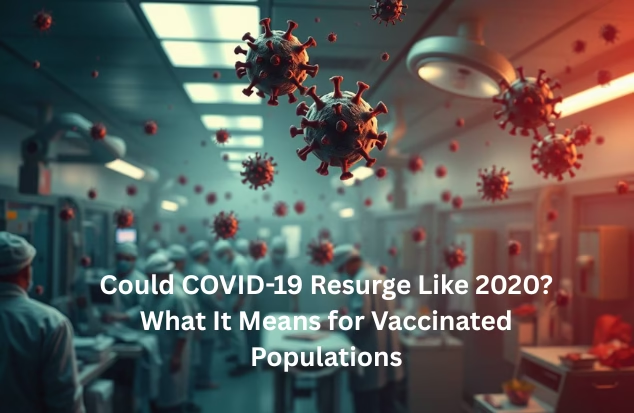US English Introduction: A Pandemic We Thought Was Behind Us?
When the world slowly emerged from the shadows of the COVID-19 pandemic, most of us hoped it was a chapter we’d never revisit. The year 2020 changed the course of modern history — lockdowns, overwhelmed hospitals, and global disruptions became our new reality. Vaccination campaigns rolled out swiftly across nations, and eventually, life began to feel somewhat normal again.

But now, a pressing question looms: Can COVID-19 spread again like it did in 2020? And if it does, what impact will it have on people who have already been vaccinated?
Let’s explore these concerns through facts, possibilities, and the evolving nature of the virus.
Could COVID-19 Spread Again Like in 2020?
Technically, yes — but it’s highly unlikely to occur in the same manner as the initial global outbreak.
Here’s why:
-
Virus Evolution and Immunity:
COVID-19, like all viruses, continues to evolve. New variants such as Omicron and its subvariants are more transmissible but generally less deadly than the original strain. The global population now has some degree of immunity — either through vaccination, past infections, or both. -
Wider Surveillance and Response Systems:
Most countries now have better infrastructure to detect and manage outbreaks. Testing, genome sequencing, contact tracing, and rapid response mechanisms are stronger than they were in early 2020. -
Public Awareness:
Unlike in 2020, people today are more informed. Practices like masking during outbreaks, maintaining hygiene, and avoiding crowded spaces when ill have become ingrained habits in many parts of the world.
However, we can’t completely dismiss the possibility of future waves. Respiratory viruses like COVID-19 often show seasonal trends and may resurge under the right conditions — especially if a new and highly mutated variant appears.
What About Vaccinated People? Are They Safe?
Vaccinated individuals are significantly more protected than those without any immunization. However, protection doesn’t mean immunity from infection.
Here’s how it plays out:
-
Reduced Severity:
While breakthrough infections can happen, fully vaccinated people — especially those with booster doses — are far less likely to develop severe symptoms, require hospitalization, or die from the virus. Vaccines essentially convert a potentially deadly illness into a milder, flu-like infection for most. -
Immunity Waning Over Time:
Immunity, whether from vaccines or past infections, tends to decrease over several months. This is why booster doses are important, especially for the elderly and high-risk individuals. People who were vaccinated early in the pandemic may need updated shots to stay protected. -
Updated Vaccines Against New Variants:
Pharmaceutical companies like Pfizer and Moderna have begun updating vaccines to target newer variants more effectively. These updated versions are designed to respond to the latest virus structures, providing stronger protection. -
Long COVID Risk Still Exists:
Even among vaccinated individuals, there is still a risk — albeit lower — of developing Long COVID. This condition, marked by lingering symptoms like fatigue, brain fog, and breathing difficulty, remains a concern for researchers and healthcare providers.
Possible Global Impact of a New Surge
If COVID-19 were to surge again globally, the impact would likely differ from 2020 in several key ways:
-
Healthcare systems are more prepared. Most hospitals have protocols, stockpiles, and trained staff to handle COVID-19 cases more effectively.
-
Economic shutdowns are unlikely. Governments now prefer targeted interventions over nationwide lockdowns to avoid massive economic losses.
-
Travel disruptions would be selective. Instead of complete international bans, we might see country-specific entry rules, depending on outbreak zones.
-
Education and work culture have adapted. Schools and companies have embraced hybrid models, allowing for smoother transitions if remote operations are temporarily needed again.
That said, vulnerable populations remain at risk — especially in regions with low vaccination coverage or under-resourced healthcare systems.
Should We Worry? Or Just Stay Cautious?
Panic isn’t necessary — but preparedness is wise.
Living with COVID-19 doesn’t mean ignoring it. It means accepting its presence while minimizing its impact through science, habits, and vigilance.
Here’s what you can do:
-
Stay up to date with vaccinations and boosters.
-
Wear a mask in crowded or poorly ventilated areas, especially during known waves.
-
Monitor local health updates and be responsible about symptoms — stay home if you’re unwell.
-
Encourage vaccination among your family and community, particularly for elderly or immunocompromised people.
Final Thoughts: Hope With a Hint of Caution
COVID-19 is unlikely to return with the same fury as in 2020 — but it’s not gone, and probably never will be entirely. It may become like the flu: a seasonal challenge that we manage, not fear.
For vaccinated people, the threat is more of a nuisance than a danger. The real victory lies not just in avoiding the virus, but in responding smarter than before.
The lessons of the pandemic aren’t just medical — they’re about resilience, adaptability, and collective responsibility. Let’s use them well, and stay one step ahead.



